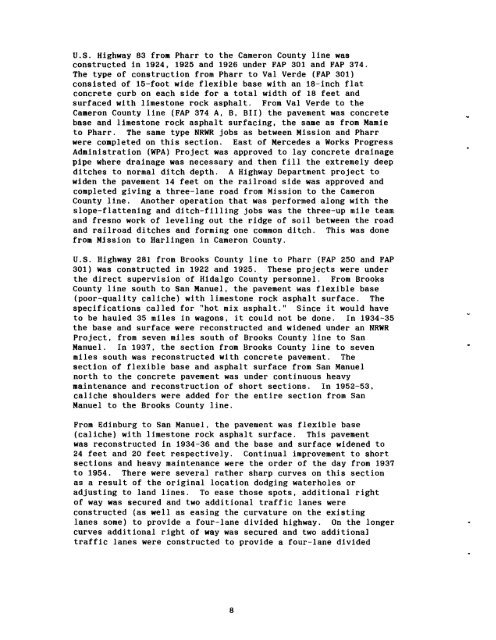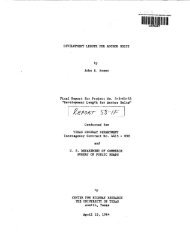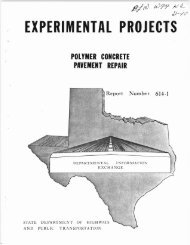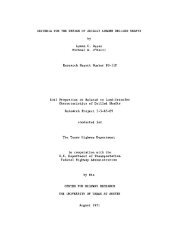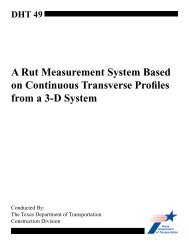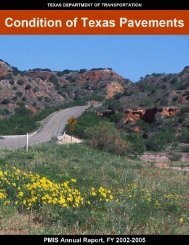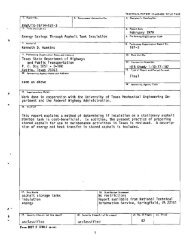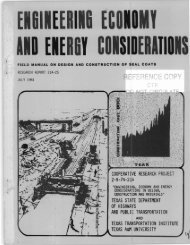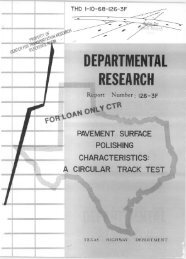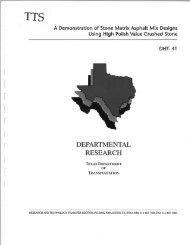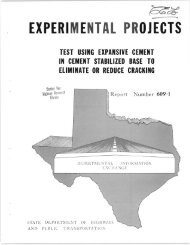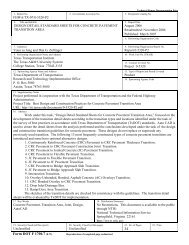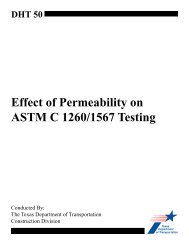HISTORY OF THE TEXAS HIGHWAY DEPARTMENT ... - CTR Library
HISTORY OF THE TEXAS HIGHWAY DEPARTMENT ... - CTR Library
HISTORY OF THE TEXAS HIGHWAY DEPARTMENT ... - CTR Library
Create successful ePaper yourself
Turn your PDF publications into a flip-book with our unique Google optimized e-Paper software.
U.S. Highway 83 from Pharr to the Cameron County line was<br />
constructed in 1924, 1925 and 1926 under FAP 301 and FAP 374.<br />
The type of construction from Pharr to Val Verde (FAP 301)<br />
consisted of 15-foot wide flexible base with an 18-inch flat<br />
concrete curb on each side for a total width of 18 feet and<br />
surfaced with limestone rock asphalt. From Val Verde to the<br />
Cameron County line (FAP 374 A, B. BII) the pavement was concrete<br />
base and limestone rock asphalt surfacing, the same as from Mamie<br />
to Pharr. The same type NRWR jobs as between Mission and Pharr<br />
were completed on this section. East of Mercedes a Works Progress<br />
Administration (WPA) Project was approved to lay concrete drainage<br />
pipe where drainage was necessary and then fill the extremely deep<br />
ditches to normal ditch depth. A Highway Department project to<br />
widen the pavement 14 feet on the railroad side was approved and<br />
completed giving a three-lane road from Mission to the Cameron<br />
County line. Another operation that was performed along with the<br />
slope-flattening and ditch-filling jobs was the three-up mile team<br />
and fresno work of leveling out the ridge of soil between the road<br />
and railroad ditches and forming one common ditch. This was done<br />
from Mission to Harlingen in Cameron County.<br />
U.S. Highway 281 from Brooks County line to Pharr (FAP 250 and FAP<br />
301) was constructed in 1922 and 1925. These projects were under<br />
the direct supervision of Hidalgo County personnel. From Brooks<br />
County line south to San Manuel. the pavement was flexible base<br />
(poor-quality caliche) with limestone rock asphalt surface. The<br />
specifications called for "hot mix asphalt." Since it would have<br />
to be hauled 35 miles in wagons, it could not be done. In 1934-35<br />
the base and surface were reconstructed and widened under an NRWR<br />
Project. from seven miles south of Brooks County line to San<br />
Manuel. In 1937, the section from Brooks County line to seven<br />
miles south was reconstructed with concrete pavement. The<br />
section of flexible base and asphalt surface from San Manuel<br />
north to the concrete pavement was under continuous heavy<br />
maintenance and reconstruction of short sections. In 1952-53,<br />
caliche shoulders were added for the entire section from San<br />
Manuel to the Brooks County line.<br />
From Edinburg to San Manuel, the pavement was flexible base<br />
(caliche) with limestone rock asphalt surface. This pavement<br />
was reconstructed in 1934-36 and the base and surface widened to<br />
24 feet and 20 feet respectively. Continual improvement to short<br />
sections and heavy maintenance were the order of the day from 1937<br />
to 1954. There were several rather sharp curves on this section<br />
as a result of the original location dodging waterholes or<br />
adjusting to land lines. To ease those spots, additional right<br />
of way was secured and two additional traffic lanes were<br />
constructed (as well as easing the curvature on the existing<br />
lanes some) to provide a four-lane divided highway. On the longer<br />
curves additional right of way was secured and two additional<br />
traffic lanes were constructed to provide a four-lane divided<br />
8


